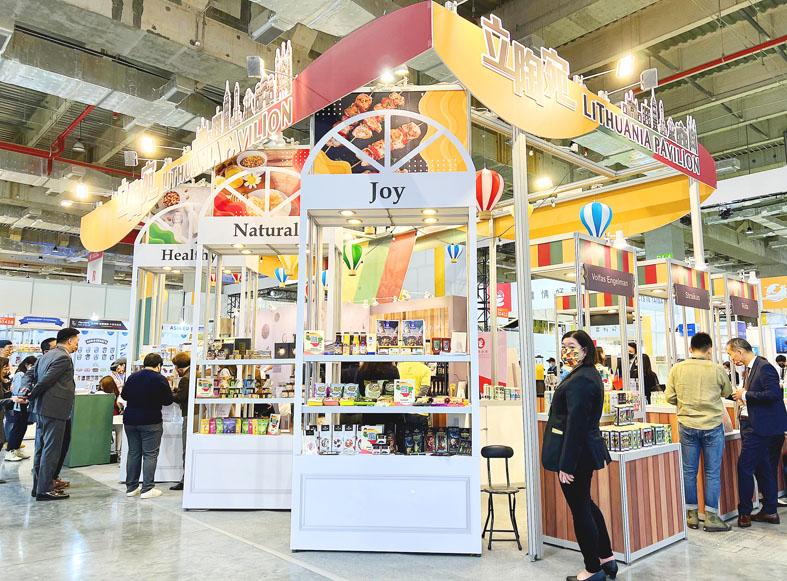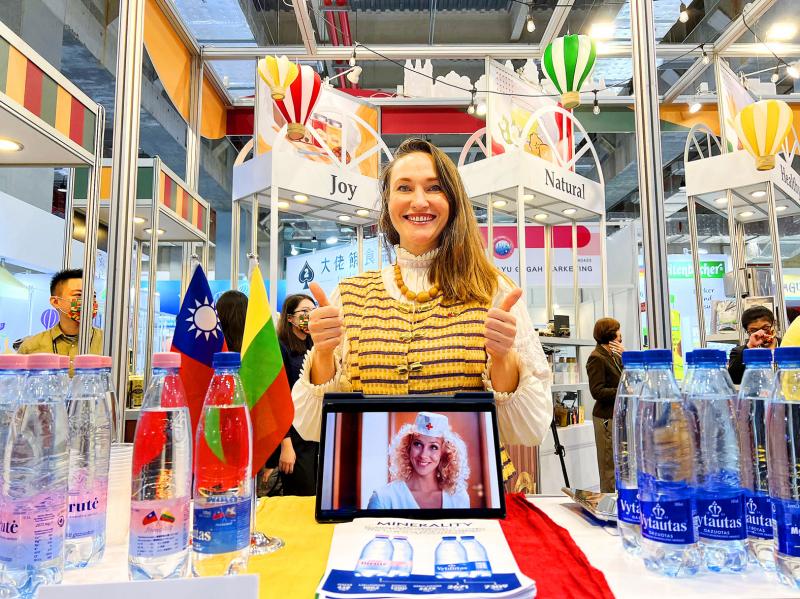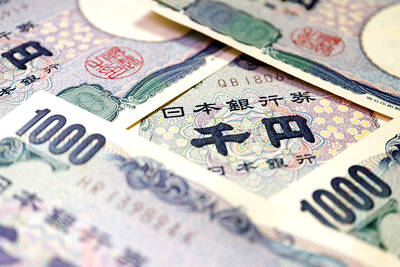The annual international food show Food Taipei opened yesterday, with the first-ever Lithuanian pavilion drawing a lot of attention.
The Lithuanian pavilion is one of 15 national pavilions featured at the show, and is participating for the first time because of the growing friendship and mutual support between the two countries, Taiwan External Trade Development Council (TAITRA, 外貿協會) chairman James Huang (黃志芳) said.
The pavilion, which features 25 companies, including importers and distributors of Lithuanian products, opened with a traditional dance performance and Huang presenting a large block of chocolate decorated with depictions of Taiwan and Lithuania, a heart and a Christmas tree.

Photo: CNA
“Lithuania is our new friend in Europe. It is a very friendly nation that supports Taiwan wholeheartedly and TAITRA reciprocated by inviting some of the Lithuanian pavilion participants,” Huang said.
Huang was referring to the Baltic state allowing Taiwan to open a representative office in Vilnius last month using the name “Taiwanese” as its official title. Taiwan’s representative offices in other European countries usually use “Taipei” in their official title.
Huang said he believed Taiwanese would be eager to buy Lithuanian products to show their gratitude to the country, adding that Lithuania can use the opportunity to introduce its products to Taiwan.

Photo: CNA
Two products featured at the Lithuanian pavilion are a special buckwheat grain that Lithuanians boil and eat with butter and a high mineral content spring water.
Ausra Andriuskaite, chairwoman of the Lithuanian community in Taiwan, said that even though there are only about 22 Lithuanian residents in Taiwan, she is still confident that Lithuania’s food products would find success in Taiwan, because consumers have similar preferences.
“Lithuanians and Taiwanese like to eat good quality and healthy food, and food from Lithuania is exactly like that,” said Andriuskaite, who is married to a Taiwanese and has lived in Taiwan for the past seven years.
“Taiwanese also like to try new things and they support Lithuania, so for sure they will want to taste the country’s food products,” she added.
Taiwan’s bilateral trade with Lithuania totaled US$155.692 million in the first 11 months of this year, with US$116.863 million in exports and US$38.829 million in imports, Bureau of Foreign Trade statistics showed.
Another national pavilion that drew a lot of attention was the Indonesian showcase, which features 10 companies offering food, snacks and sauces from global brand names, as well as small and medium-sized enterprises.
Trade analyst Muhammad Fuad Hamzah from the Indonesia Economic and Trade Office to Taipei said that Indonesian snacks are popular in Taiwan, many of which can be found at Southeast Asian grocery stores and big supermarket chains.
Taiwan imported US$44.802 million of Indonesian processed food from January to last month, an 11 percent increase from the same period last year, Fuad said.
Meanwhile, the Somaliland pavilion attracted scores of visitors eager to sample the country’s cooked food, such as a meat jerky known as muqmad and a confectionery called halwa.
Somaliland Representative to Taiwan Mohamed Hagi said it is the first time his office is taking part in the trade show, and their objective is to share the country’s culinary culture with Taiwanese before bringing a larger delegation of food manufacturers and distributors next year.
“Next year, we are planning to have a very big presence, and to invite our food companies and big restaurants to exhibit more about Somaliland’s culture to Taiwanese people,” he said.
Food Taipei, which runs until Saturday, is showcasing products from 28 countries and 478 businesses, spread out over 1,120 booths at Taipei Nangang Exhibition Center’s Hall 2.

AI TALENT: No financial details were released about the deal, in which top Groq executives, including its CEO, would join Nvidia to help advance the technology Nvidia Corp has agreed to a licensing deal with artificial intelligence (AI) start-up Groq, furthering its investments in companies connected to the AI boom and gaining the right to add a new type of technology to its products. The world’s largest publicly traded company has paid for the right to use Groq’s technology and is to integrate its chip design into future products. Some of the start-up’s executives are leaving to join Nvidia to help with that effort, the companies said. Groq would continue as an independent company with a new chief executive, it said on Wednesday in a post on its Web

RESPONSE: The Japanese Ministry of Finance might have to intervene in the currency markets should the yen keep weakening toward the 160 level against the US dollar Japan’s chief currency official yesterday sent a warning on recent foreign exchange moves, after the yen weakened against the US dollar following Friday last week’s Bank of Japan (BOJ) decision. “We’re seeing one-directional, sudden moves especially after last week’s monetary policy meeting, so I’m deeply concerned,” Japanese Vice Finance Minister for International Affairs Atsushi Mimura told reporters. “We’d like to take appropriate responses against excessive moves.” The central bank on Friday raised its benchmark interest rate to the highest in 30 years, but Bank of Japan Governor Kazuo Ueda chose to keep his options open rather than bolster the yen,

Even as the US is embarked on a bitter rivalry with China over the deployment of artificial intelligence (AI), Chinese technology is quietly making inroads into the US market. Despite considerable geopolitical tensions, Chinese open-source AI models are winning over a growing number of programmers and companies in the US. These are different from the closed generative AI models that have become household names — ChatGPT-maker OpenAI or Google’s Gemini — whose inner workings are fiercely protected. In contrast, “open” models offered by many Chinese rivals, from Alibaba (阿里巴巴) to DeepSeek (深度求索), allow programmers to customize parts of the software to suit their

Global server shipments are expected to surge to 15 million units next year, from 4 million units this year, with artificial intelligence (AI) servers accounting for about 30 percent, driven by massive capital spending by major cloud service providers, the Market Intelligence and Consulting Institute (MIC) said on Thursday last week. Major cloud service providers — including Google’s parent company Alphabet Inc, Microsoft Corp, Amazon.com Inc and Meta Platforms Inc — are projected to budget US$450 million for capital expenditure next year, up from US$400 million this year, MIC ICT [information and communications technology] Industry Research Center director Edward Lin